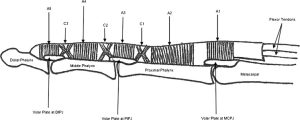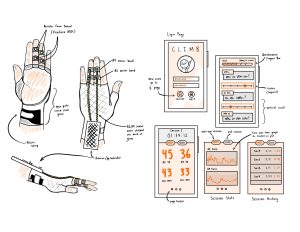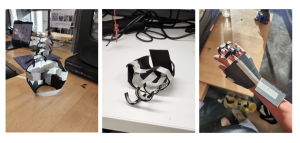General Update
This week, Josh, Alex, and Jubi produced a design report detailing the use-cases, requirements, trade-off-analyses, implementation details and more.
Design Report
Risks and risk mitigation
One potential risk is identified in the sensor amplifier circuit. Our goal is to amplify the sensor output to enhance our systems force-reading precision by providing a larger voltage range for the sensor output. Failure to obtain fine-grain readings may result in innacurate readings, which may fire alarms unecessarily or fail to fire alarms upon force-threshold excession. To mitigate this, we are working to determine the best amplifier circuit model (gain, phase, etc.) to obtain sufficient sensor output ranges with respect to our power constraints.

overall design changes
Instead of the STM32F4E Nucleo Board, we will be utilizing the ESP-WROOM-32 board as our controller because of its size advantages, built-in peripherals (more ADCs, Bluetooth), and ease-of-use via Arduino ESP32 libraries, as compared to bare-metal development on the STM.

schedule
The schedule remains the same as we are on track.
GANTT Chart
Guidance Questions
Part A. Global FactoRS written by Alexander
Our product aims to be used by climbers of all skill levels, regardless of prior experience. As an injury prevention device, our device should be accessible to all users, otherwise it would not achieve our goal of protecting the health of all climbers. As a result, we want our system (consisting of both the wearable device and android app) to be as straightforward to use as possible, with little room for confusion on the part of the user. We achieve this by ensuring that the wearable device is sturdy and has clearly marked labels to indicate how it should be worn to best prevent pulley injuries. Additionally, the app is designed to show the climber the most important information first, while providing an experience that is easy to navigate and adjust to the user’s preferences. Additionally, a lack of biomechanical knowledge should not inhibit the user’s ability to correctly adjust their own alarm thresholds, so we have included a questionnaire which will assist the user by suggesting alarm thresholds based on their responses to carefully selected questions.
Climbing is a sport which can take place both indoors and outdoors. As a result, the environment in which our device is used must be considered and accounted for in our design. It is important to note that climbing is inherently rigorous, especially on the fingers, so our device will need to be able to withstand physical wear and tear exerted by the climbing wall. Our initial goal is for this device to be used in indoor climbing, where there are less outside factors that could impact the device’s effectiveness (dirt, wind, temperature, sand, water). Ideally, our product is meant to provide protection for climbers both indoors and outdoors, and as a result, geographic location of the climber could impact the durability and effectiveness of the device. We will consider the extremes of these factors during testing. One more thing to note is that outdoor climbers are often in locations where there is little to no internet connection. We solve this problem by sending data from the wearable device to the mobile app (and vice-versa) via Bluetooth, which can be used at any geographic location regardless of internet strength.
Part B. Cultural FactoRS written by joshua
One aspect of climbing culture that our product solution slightly pushes the boundary of acceptable on is the notion that the hands must be bare while climbing. Most climbers would agree with the idea that “a glove could never be as good as a really exceptional climber’s hands are” or “strengthening your hands is what climbing is all about”. This is a mindset common in rock climbers. Unfortunately, our product does cover a small portion of the hand, in particular the area under the finger joints. As a result, climbers at first may be hesitant to utilize our product, however, one of our product’s goals is to emphasize the utility of relatively unobtrusive on-hand climbing gear.
Our product aims to broaden the horizons of climbers with their regard to on-hand climbing gear by demonstrating its benefits (safety, healthcare costs) and minimized drawbacks (obtrusiveness, taking away the ‘rawness’ of climbing). In all, our product aims to eliminate the cultural mindset of “not going bare-handed is bad/weird”, by demonstrating that it is actually very beneficial and not too different!
part C. Environmental FactoRS Written by jubahed
Our product’s main consideration of environmental factors is that it is ineffective towards the environment. Most climbing gear, depending on how it is used, can have adverse effects on the environment. Some examples are improper disposal of gear material like nylon and aluminum mid-climb, climbing chalk altering the pH of rocks and harming organisms, and the production of rock-climbing shoes emitting more carbon dioxide than the rest of the gear. In contrast, our product aims to have zero effect on the surrounding environment by using eco-friendly fabric, being securely strapped to the individual to avoid accidental disposals, and using zero chemicals to avoid potential harm to surrounding organisms. The need our product solution fills is the lack of eco-friendly gear in the field. By introducing gear like our product, we can emphasize this alternative of eco-friendly climbing products and move the field towards a more eco-friendly rock-climbing experience.














